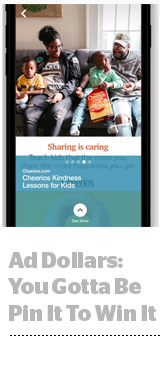
Pinterest is growing its ad inventory with a new promoted carousel format, which moved out of beta on Thursday.
Carousels, which allow advertisers to include up to five images within a single format, can appear within the Pinterest main feed as a related pin recommendation or through search. Users tap the cover image and then swipe or tap their way through the cards.
Most other platforms already have versions of the paid carousel, including Facebook (rolled out 2015), Google (2016), Instagram (2017) and Twitter (2017).
But Pinterest has been making up for lost time. EMarketer predicts Pinterest will double its ad revenue to $1 billion by 2020, and the company is rumored to be exploring an IPO.
Perhaps in anticipation of going public, Pinterest’s ad products seem to be getting more love recently.
Since the beginning of the year, Pinterest has scaled its sales team and introduced new offerings, including shopping ads, promoted autoplay video and a creative badge for its marketing partner program. In mid-October, Pinterest revamped its self-serve ad platform for the first time since 2016 to make it easier for smaller advertisers to spend.
But carousel ads, in particular, are a “foundational product” for Pinterest, said Francis Larkin, head of ads product marketing.
And that’s because they’re not tied to any one objective. Some advertisers use them to spread awareness while others want to generate performance and click-throughs to a landing page. (Users cannot yet shop directly from within a carousel format.)
Cheerios, for example, tested Pinterest’s carousel to promote a content series that teaches kindness to children. Each card within the carousel included a different lesson, such as saying “please” and “thank you” or “sharing is caring.” The campaign led to an 11.4 point lift in brand awareness and an 8.6 point lift in message association.
REI, on the other hand, had a DR goal for its test of the format, which exceeded the outdoor gear brand’s CTR benchmark rate by 32%.
Larkin declined to disclose how much the new format would expand Pinterest’s ad load, but noted that it should “dramatically increase the amount of content on Pinterest.”
“We have a vision of making ads relevant, even as relevant as the content itself, and we see carousels as one way to do that,” he said.
Pinterest also wants to woo advertisers with an increased focus on measurement. Pinterest has a viewability partnership with Moat, a foot traffic-tracking partnership with NinthDecimal and relationships with 12 other third-party measurement providers in its marketing partner program.
Pinterest also says it’s “working closely” with the Media Rating Council (MRC), although there’s no update yet on when or whether Pinterest will submit itself for an audit à la Facebook, Google and Twitter. Even so, the company’s head of measurement science and insights, Gunnard Johnson, joined the MRC’s board of directors earlier this year.
This post was syndicated from Ad Exchanger.

